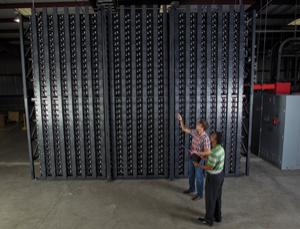Texas mega-battery aims to green up the grid
 IN A remote corner of west Texas, in the shadow of a sprawling wind farm, one of the world’s largest batteries was switched on last week. Deep in oil country, the battery is at the vanguard of efforts to help renewable energy sources realise their potential and, ultimately, oust fossil fuels in the US.
IN A remote corner of west Texas, in the shadow of a sprawling wind farm, one of the world’s largest batteries was switched on last week. Deep in oil country, the battery is at the vanguard of efforts to help renewable energy sources realise their potential and, ultimately, oust fossil fuels in the US.Built for energy giant Duke Energy by local start-up Xtreme Power, the array is the biggest and fastest battery in the world. It can deliver 36 megawatts of wind power to the grid over a period of 15 minutes.
The battery’s job is to act as a buffer, smoothing out the supply of electricity from the 153 MW Notrees wind farm nearby. The intermittent nature of wind power means fossil fuel powered turbines often have to step in to match energy supply with demand. The battery at Notrees bridges the gap, says Haresh Kamath of the Electric Power Research Institute in Washington DC. “When you ramp power plants up and down they lose efficiency,” he says. “It used to be the best way to do it, but if we have storage like Notrees, we make wind plants more efficient.”
It also makes the entire grid more resilient to spikes in demand, because battery arrays can respond almost instantly, whereas natural gas power plants take about 15 minutes to boost their output.
The Notrees battery is the first in a wave of new grid-connected storage systems funded in 2009 by power companies and the US Department of Energy (DOE) that are expected to come online this year. Notrees has bus-sized, lead-acid battery modules with high surface area electrodes and multiple terminals, so electricity flows in and out quickly.
Most of the other DOE-funded projects look very different. The California-based Pacific Gas and Electricity Company will soon start filling depleted gas wells near Bakersfield with compressed air that can deliver 300 MW of power. In Modesto, a wind farm will be backed up by a 25 MW storage system based on a zinc-chloride flow battery, which is charged by filling with a reusable electrolyte liquid. The battery will replace a planned 50 MW fossil fuel plant.
“There are storage projects all over the country, and 2013 is the year for all of these to come online and start working,” says Mike Gravely of the California Energy Commission. “The goal is to give you enough energy to manage variability, or to give you enough time to find alternative resources.”
These facilities are far too small to have a direct impact on how energy is generated and stored in the US. Instead, the goal is for them act as test beds for determining how best to maintain a steady supply of renewable electricity to the grid when the wind drops, the sun isn’t shining, or demand spikes. In 2010, US energy secretary Steven Chu stressed the importance of such storage if the country is ever to wean itself off fossil fuels.
“Without technological breakthroughs in efficient, large-scale energy storage, it will be difficult to rely on intermittent renewables for much more than 20 to 30 per cent of our electricity,” Chu noted.
“The whole goal is to build a grid that is flexible enough to achieve any level of renewables,” says Kamath. “Limitations on the grid have made it look like renewables are a problem, but the grid was never designed for them. It needs to be,” he adds.
You can return to the main Market News page, or press the Back button on your browser.

